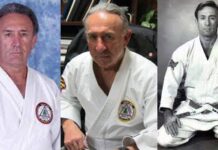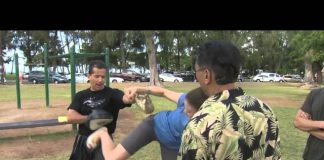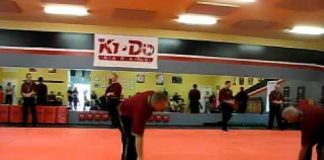Page 1 of the photo-insert in The Secret Man between pages 112 and 113 bottom left photo shows the alleged “bulletproof glass” in a wooden holder. On the transparent panel is a small impact mark which has been circled. Dux tells us this mark is a “9-mm-bullet hit”. In the next column on the same page, two helpers brace the wooden support which clamps the alleged “bullet-proof glass” in place. In one picture Dux is about to punch, in the picture below he has punched through the clear panel.
There are two kinds of bulletproof glass which I know of. One kind is actual glass laminated and layered with plastic in between the glass layers. Each layer has a plastic film between each pane of glass to maintain its integrity. When hit with a round, it spreads the impact over a larger area than the point of impact. It shatters in a radial pattern from the point of impact, with multiple layers of glass shattering, stopping the bullet. It’s often found in bank windows, some armored cars, etc., and is expensive. The other “bulletproof glass” isn’t glass at all, but a shatter-resistant polycarbonate brand-named Lexan.
In his claims, Dux misspells it as “Lexon Bulletproof Glass”. With the right thickness (generally at least 3/4″), Lexan can be an alternative to traditional bulletproof glass. When a round hits Lexan, it tends to somewhat melt around the impact due to the heat of the round (depending upon size of round, distance, weapon used to fire, etc.). Lexan distributes the impact over an area wider than the initial point of impact–same theory as bulletproof glass, or a bulletproof vest. There are different thicknesses of Lexan available depending upon the intended use. The thicker the substance, the more effective against shattering–just like “traditional” plexiglass. Where exposed to sunlight (as with an armored car), Lexan should be replaced once a year per manufacturer’s suggestion (ultraviolet light casues it to degrade and it can shatter). Different thicknesses of Lexan are used in a wide variety of places–from bus shelters, hospitals, mental institutions, jails, gas station attendant booths, tool booth enclosures, etc. and newer armored cars.
The clear panel in Dux’s book appears to be rather thin for traditional layer/laminated bulletproof glass. Furthermore, in Dux’s photo the clear panel definately does not appear to be 3/4 inch thickness. Both Alexander and Richardson used the term “plexiglass” in their statements, contradicting Dux’s claim in The Secret Man to have been “the first person to shatter bulletproof glass”. Was it Lexan? Although we can’t be certain, we can make an educated guess from what evidence is available–the believability of Dux vs. the believability of the two men who contradict his claims. Dux didn’t bother to document his claim by having an expert verify what the panel was. Certainly someone who was planning on breaking a substance like Lexan would want the world to know he wasn’t pulling a fast one with weaker plexiglass–and would go through the trouble of having someone qualified verify his claim to be using the correct substance of a thickness that would actually stop a round prior to a public demonstration.
Another consideration is that Lexan and Plexiglass can can crack around an impact, Lexan more so if it has been degraded by ultraviolet rays. In The Secret Man photo, there appear to be cracks radiating from the impact. Dux claimed that the circled impact in the clear panel was a “9-mm-bullet hit”. I’d guess a .17 or .20 cal. pellet round, if that, because the panel doesn’t look thick enough to withstand a greater impact. Not enough is known without having seen what was fired. With Dux’s record, his word alone is not enough to go on.
Cracks WOULD weaken plexiglass or Lexan to the point where a blunt non-ballistic impact could cause it to shatter. It would not take a trained martial artist to shatter weakened material. Any healthy somewhat athletic person should probably be able to do this–but keep in mind that plexiglass can leave cut and scratch marks when it shatters. Plexiglass or Lexan? Two reliable witnesses in separate statements say the clear panel was indeed plexiglass.
Alexander’s statement also mentions the shattering of two champagne bottles which he testifies were made out of “candied glass”. Richardson supports this allegation with a separate statement of his own:
“FACT 2. The bottles that he used for his so-called breaks in his demo were “candy glass” used on movie sets and I remember him receiving them from one of the students in my group who moonlighted as a stuntman. Mean while all the time Mr. Dux thought it was all a big joke, to him it was o.k. to fake his martial arts abilities, after all he was the great “Frank Dux”. Why would I continue to train in an environment surrounded by deceit and illusion.[….]” ( [Only registered and activated users can see links. ] if nothing appears on this page, highlight the page with your cursor– white print on white background.)
Let’s take a look at Frank’s book again. On page 2 of the photo insert between pages 112 and 113 of The Secret Man, the top photograph appears to show Frank Dux preparing to kick what could be two champagne bottles. The larger picture underneath shows the bottles shattering–indeed, they don’t just shatter, they appear to turn to powder–chunks of the “glass” fly through the air leaving powder trails, something I’ve never seen real bottle glass do from an impact. The bottom two photos show Dux apparently using a hammerfist to pulverize what appears to be a Jack Daniel’s whisky bottle. This bottle also powders, instead of shattering. One can even see pieces of the apparent whisky bottle trailing powder behind as they fly from the impact–something glass does not do.
Candy glass on the other hand, does powder when impacted in a certain way–it is after all, made from finely ground confectioner’s sugar. This is VERY apparent in the photos which Dux was nice enough to provide himself.
Did Frank Dux shatter bulletproof glass or break real glass bottles at the 1993 Paris demo? The evidence points to “no”. I’m inclined to believe Alexander and Richardson, even if they had fallen away from Dux, because of the fact that not a single claim by Dux (military, martial arts/ninjutsu, secret op, etc) has been shown sound since he first emerged onto the public scene in 1980 with his claims about having fought in Southeast Asia, winning secret “Kumite” tournaments, and the like. I am also inclined to believe what I can see in the Pictures provided in Dux’s own book.
Over time, when threatened by the facts, Frank Dux has a tendancy to change his story and deny he ever made the claims despite the fact that many of them were documented by reliable sources. Over a period of 24 years, Frank Dux has not shown himself to be reliable in matters relating to his own history and accomplishments. He has yet to present any convincing evidence of real accomplishments to the world. I do not find his claims concerning Paris 1993 believable.
by M.C. Busman






